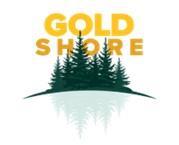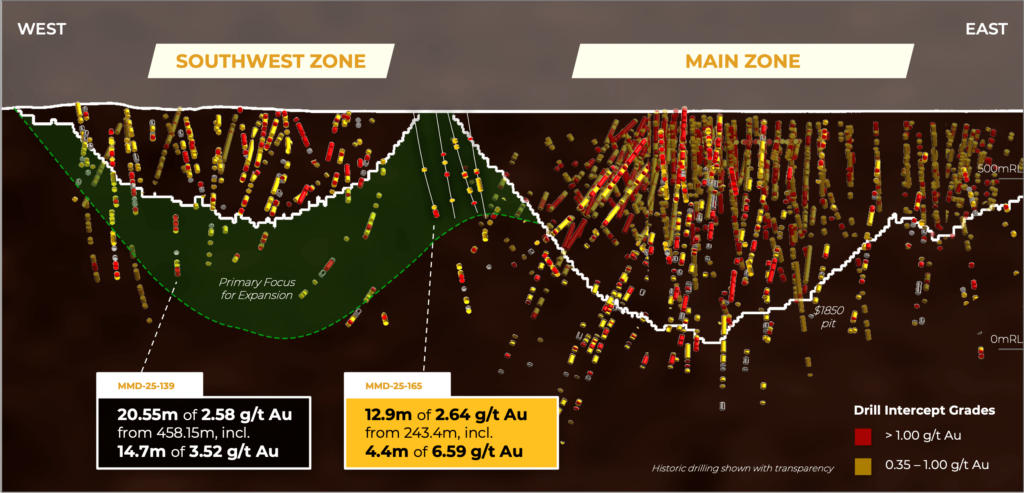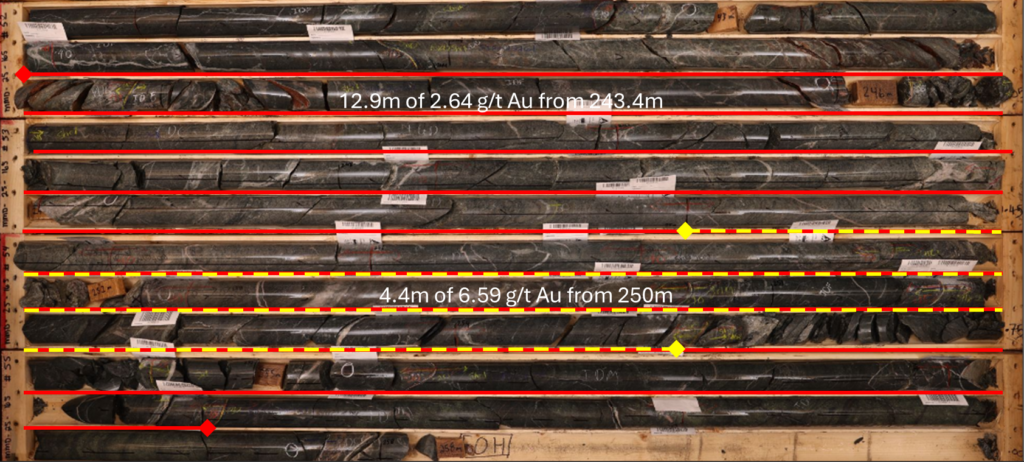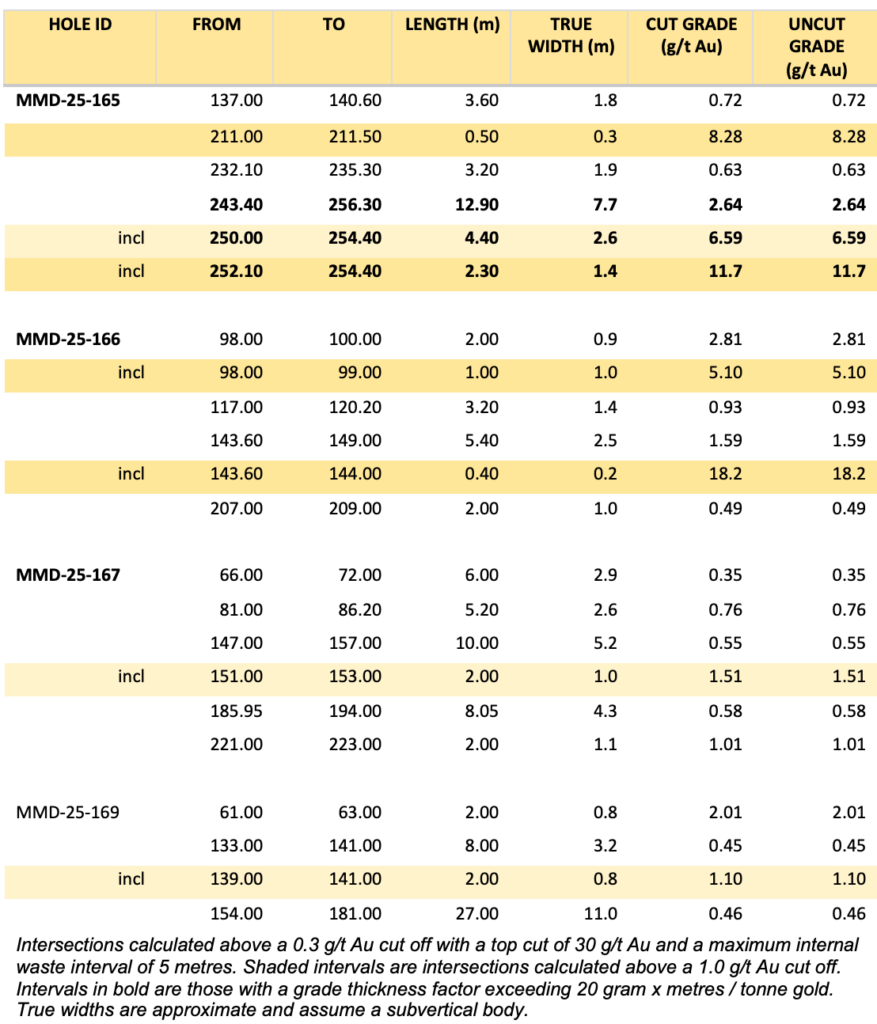
Goldshore Discovers Additional Mineralization Between the Southwest and Main Zones

|
Michael Henrichsen, CEO of Goldshore commented, “These results further validate our decision to expand the winter drill program by 5,000 meters with the objectives of deepening the Southwest conceptual open pit and to close the gap between the Southwest and Main pits. This winter’s drill program has demonstrated the emerging nature of the Moss Gold Deposit and its growth potential. We look forward to continued drilling to realize the full ounce potential of the deposit in the coming months.”
Highlights:
- Results from two drill holes targeting the gap between the Main and Southwest Zones intersected new high-grade mineralization representing a combined true width mineralized corridor of 75m connecting the two zones with best intercepts of:
- 12.9m of 2.64 g/t Au from 243.4m in MMD-25-165, including
- 4.4m of 6.59 g/t Au from 250m, and
- 2.0m of 2.81 g/t Au from 98.0m in MMD-25-166, and
- 5.4m of 1.59 g/t Au from 143.6m, including
- 0.4m of 18.2 g/t Au from 143.6m
- 12.9m of 2.64 g/t Au from 243.4m in MMD-25-165, including
- Two holes drill testing the surface extension of deep mineralized shear zones in the Main zone successfully identified the continuation of these shears to surface with best intercepts of:
- 10.0m of 0.55 g/t Au from 147m in MMD-25-167, including
- 2.0m of 1.51 g/t Au from 151m, and
- 8.05m of 0.58 g/t Au from 185.95m, and
- 27m of 0.46 g/t Au from 154m in MMD-25-169
- 10.0m of 0.55 g/t Au from 147m in MMD-25-167, including
Technical Overview
Figure 1 shows the location of the drill holes being reported with respect to the planned winter drill program, while Figure 2 illustrates a long section through drill hole MMD-25-165 that demonstrates the potential to join the Main and Southwest Zones as a single mineralized body. Tables 1 & 2 summarize significant intercepts and drill hole locations, respectively.

Figure 1: Summarizes the ongoing winter 2025 drill program targeting resource expansion within the conceptual open pit outlined in grey. Drill holes being reported are highlighted in red.

Figure 2: Long section through MMD-25-165 illustrating the existence of near surface mineralized shears and demonstrating the potential to join the Main and Southwest Zones as a single mineralized body.
Drilling has targeted the Golden Gate prospect, a critical gap in drilling data between the Main and Southwest Zones, and the surface extension of deeper modelled mineralized shear zones along the southern boundary of the Main Zone. Both areas aim to identify sufficient near surface mineralization between the conceptual Main and Southwest pits to merge the two pits together. The shallow portion of these areas are only accessible for drilling from lake ice and can be infilled at depth from near shore drill sites.
Hole MMD-25-165 targeted a drilling data gap between the Main and Southwest zones collared into a sequence of andesitic and dacitic volcanic rocks. Swarms of weak to moderately sheared, sericite-silica-hematite altered diorite and granodiorite dykes were encountered after 200m depth becoming increasingly mineralized with depth with intercepts of 3.2m of 0.63 g/t Au from 232.1m and 12.9m of 2.64 g/t Au from 243.4 including 9.45m of 3.46 g/t Au from 9.45m (Figure 3). Down hole orientation data does not align with either the Main or Southwest zone shears with the new mineralization likely part of a segmented lens along the Snodgrass Lake fault splay system. The hole was terminated in mineralized diorite due to depth limitations of the ice thickness.
Hole MMD-25-166 was stepped ahead by 130m of MMD-24-165 and encountered an unexpected increase in overburden thickness increasing to approximately 80m from the 38m in MMD-25-165. This resulted in an approximately 20m gap in coverage between the two holes and the erratic erosional surface beneath overburden. The hole intersected a sequence locally sericite-silica altered andesitic and dacitic volcanics rocks with frequent swarms of weakly sheared and mineralized sericite-silica-hematite altered diorite and granodiorite dykes. Where more strongly sheared, the diorite and granodiorite mineralization increased with intercepts of 2.0m of 2.81 g/t Au from 98.0m, 3.2m of 0.93 g/t Au from 117m, and 5.4m of 1.59 g/t Au from 143.6m including 0.4m of 18.2 g/t Au from 143.6m. Combined with MMD-25-165, the holes have identified a new mineralized corridor with an estimated true width of 75m between the two zones. The corridor is accessible for additional drilling from the western shore of Snodgrass Lake.
Holes MMD-25-167 and MMD-25-169 targeted the southern edge of the Main Zone aiming to extend existing shears modelled at depth to surface. Both holes collared into andesitic and dacitic volcanic rocks with frequent swarms of weakly sheared and mineralized sericite-silica-hematite altered diorite and granodiorite dykes. Both holes successfully extended existing mineralized shears towards surface at similar grades with intercepts such as 10.0m of 0.55 g/t Au from 147m including 2.0m of 1.51 g/t Au from 151m and 8.05m of 0.58 g/t Au from 185.95m in MMD-25-167 and 2m of 2.0 g/t from 61m and 27m of 0.46 g/t Au from 154m in MMD-25-169. Downhole core orientation measurements align with the expected orientation of the Main Zone shears.

Figure 3: Hole MMD-25-165: Sheared and mineralized granodiorite returning 12.9m of 2.64 g/t Au from 243.4m between the Main and Southwest zones.
Table 1: Significant intercepts

Table 2: Drill Collars

Analytical and QA/QC Procedures
All samples were sent to ALS Geochemistry in Thunder Bay for preparation and analysis was performed in the ALS Vancouver analytical facility. ALS is accredited by the Standards Council of Canada (SCC) for the Accreditation of Mineral Analysis Testing Laboratories and CAN-P-4E ISO/IEC 17025. Samples were analysed for gold via fire assay with an AA finish (“Au-AA23”) and 48 pathfinder elements via ICP-MS after four-acid digestion (“ME-MS61”). Samples that assayed over 10 ppm Au were re-run via fire assay with a gravimetric finish (“Au-GRA21”).
In addition to ALS quality assurance / quality control protocols, Goldshore has implemented a quality control program for all samples collected through the drilling program. The quality control program was designed by a qualified and independent third party, with a focus on the quality of analytical results for gold. Analytical results are received, imported to our secure on-line database and evaluated to meet our established guidelines to ensure that all sample batches pass industry best practice for analytical quality control. Certified reference materials are considered acceptable if values returned are within three standard deviations of the certified value reported by the manufacture of the material. In addition to the certified reference material, certified blank material is included in the sample stream to monitor contamination during sample preparation. Blank material results are assessed based on the returned gold result being less than ten times the quoted lower detection limit of the analytical method. The results of the on-going analytical quality control program are evaluated and reported to Goldshore by Orix Geoscience Inc.
Qualified Person
Peter Flindell, PGeo, MAusIMM, MAIG, Vice-President, Exploration, of the Company, and a qualified person under National Instrument 43-101 – Standards of Disclosure for Mineral Projects, has approved the scientific and technical information contained in this news release.
Mr. Flindell has verified the data disclosed. To verify the information related to the winter drill program at the Moss Gold Project, Mr. Flindell has visited the property several times; discussed and reviewed logging, sampling, bulk density, core cutting and sample shipping processes with responsible site staff; discussed and reviewed assay and QA/QC results with responsible personnel; and reviewed supporting documentation, including drill hole location and orientation and significant assay interval calculations. He has also overseen the Company’s health and safety policies in the field to ensure full compliance, and consulted with the Project’s host indigenous communities on the planning and implementation of the drill program, particularly with respect to its impact on the environment and the Company’s remediation protocols.
About Goldshore
Goldshore is a growth-oriented gold company focused on delivering long-term shareholder and stakeholder value through the acquisition and advancement of primary gold assets in tier-one jurisdictions. It is led by the ex-global head of structural geology for the world’s largest gold company and backed by one of Canada’s pre-eminent private equity firms. The Company’s current focus is the advanced stage 100% owned Moss Gold Project which is positioned in Ontario, Canada, with direct access from the Trans-Canada Highway, hydroelectric power near site, supportive local communities and skilled workforce. The Company has invested over $60 million of new capital and completed approximately 80,000 meters of drilling on the Moss Gold Project, which, in aggregate, has had over 235,000 meters of drilling. The 2024 updated NI 43-101 mineral resource estimate has expanded to 1.54 million ounces of Indicated gold resources at 1.23 g/t Au and 5.20 million ounces of Inferred gold resources at 1.11 g/t Au. The MRE only encompasses 3.6 kilometers of the 35+ kilometer mineralized trend, remains open at depth and along strike and is one of the few remaining major Canadian gold deposits positioned for development in this cycle. Please see NI 43-101 technical report titled: “Technical Report and Updated Mineral Resource Estimate for the Moss Gold Project, Ontario, Canada,” dated March 20, 2024 with an effective date of January 31, 2024 available under the Company’s SEDAR+ profile at www.sedarplus.ca.
MORE or "UNCATEGORIZED"
Kuya Silver Confirms High-Grade Silver-Gold Vein Mineralization at Umm-Hadid with Initial Drill Results up to 1483.9 g/t AgEq over 2 Metres
Kuya Silver Corporation (CSE: KUYA) (OTCQB: KUYAF) (FSE: 6MR1) is... READ MORE
First Phosphate Closes Final Tranche of Oversubscribed Private Placement
First Phosphate Corp. (CSE: PHOS) (OTCQX: FRSPF) (FSE: KD0) is... READ MORE
GFG Receives Final Payment from the Sale of its Rattlesnake Hills Gold Project
GFG Resources Inc. (TSX-V: GFG) (OTCQB: GFGSF) announces that i... READ MORE
Goliath Receives $1,730,882 Through Warrant Exercises, Inclusive Of Crescat Capital A Longtime Strategic And Cornerstone Shareholder
Goliath Resources Limited (TSX-V: GOT) (OTCQB: GOTRF) (FSE: B4IF)... READ MORE
Robex Pours First Gold at Kiniéro on Schedule and Budget
Highlights: Gold bar weighing 2.64 kilograms (85 oz) poured in th... READ MORE












